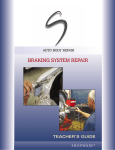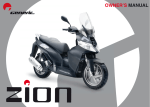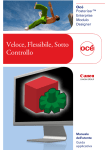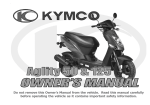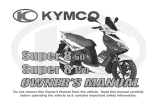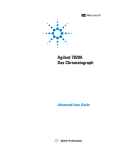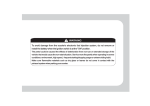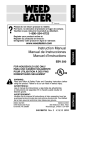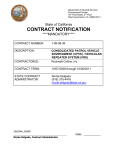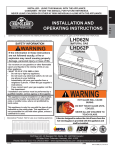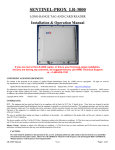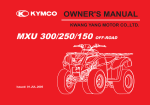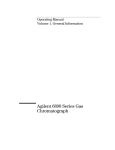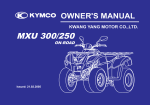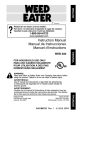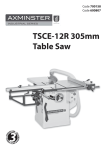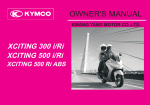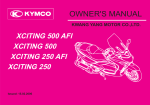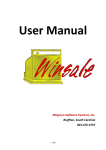Download Quannon 150 Owner`s Manual
Transcript
Do not remove this Owner’s Manual from the vehicle. Read this manual carefully before operating the vehicle as it contains important safety information. Read this manual carefully. This Owner’s Manual contains important information on safety, operation and maintenance of your KYMCO motorcycle. Any one who operates your motorcycle should carefully read and understand the contents of this manual before riding the motorcycle. For your safety, understand and follow all of the warnings contained in this Owner’s Manual and the labels applied to your motorcycle. This Owner’s Manual should be considered a permanent part of the vehicle. Keep it with your motorcycle at all times. ON-ROAD USE ONLY. This motorcycle has been designed to be used on the road. Particularly important information is called out in this manual by the following icons and notations: The SAFETY ALERT symbol with the exclamation point in the triangle means ATTENTION! BE ALERT! YOUR SAFETY CAN BE AFFECTED. WARNING Failure to follow instructions associated with a WARNING symbol could result in severe injury or death to the rider, a passenger, a bystander, or a person inspecting or repairing the motorcycle. CAUTION A CAUTION symbol indicates that special precautions must be taken to avoid damaging the motorcycle. NO TE NOTE The NOTE symbol indicates key information about a procedure or to clarify an operation. California Proposition 65 WARNING This product contains or emits chemicals known to the State of California to cause cancer and birth defects or other reproductive harm. Battery & Electrical System Damage Alert WARNING To avoid damage to the motorcycle’s electrical system, do not remove or install a battery wire when the ignition switch is in the “ON” position. TABLE OF CONTENTS Manual Icon Legend ................................................... (inside of front-cover) CA Prop 65 & Battery Warning .................................. (inside of front-cover) Table of Contents .......................................................................................... 1 SECTION 1 - SAFETY ................................................................ 2 - 8 Forward ......................................................................................................... 2 Motorcycle Safety ................................................................................... 3 - 4 Load Limits & Guidelines ............................................................................. 5 Accessories & Modifications ........................................................................ 6 Caution & Warning Labels ............................................................................ 6 Locations of Parts & Controls ................................................................ 7 - 8 SECTION 2 - CONTROLS & FEATURES ............................... 9 - 21 Serial Numbers ............................................................................................. 9 Keys ............................................................................................................. 10 Ignition Switch ............................................................................................. 10 Steering Lock ....................................................................................... 10 - 11 Right-hand Handlebar Switch .................................................................... 12 Left-hand Handlebar Switch ....................................................................... 13 Helmet Lock ................................................................................................ 14 Seat Lock .................................................................................................... 14 Tool Kit ......................................................................................................... 14 Multifunction Meter ............................................................................ 15 – 21 Speedometer ............................................................................................... 17 Odometer/Trip meter/Service meter ................................................. 18 – 19 Fuel Level Gauge ....................................................................................... 20 Clock .................................................................................................... 20 - 21 SECTION 3 - OPERATION ..................................................... 22 - 40 Pre-ride Inspection ............................................................................ 22 – 31 Engine Oil Inspection ................................................................................. 23 Brake Inspection ......................................................................................... 24 Tire Inspection ............................................................................................ 25 Fuel Level Inspection & Refilling ............................................................... 26 Steering Inspection ..................................................................................... 27 Lights Inspection ......................................................................................... 27 Horn Inspection ........................................................................................... 28 Drive Chain Inspection ............................................................................... 28 Clutch Lever & Cable Inspection ............................................................... 29 Throttle Inspection ...................................................................................... 30 Chassis Inspection ..................................................................................... 31 Starting the Engine ............................................................................. 31 - 33 Riding Your Motorcycle ....................................................................... 37 - 40 Stopping & Parking Your Motorcycle ................................................. 37 - 38 Break-in Recommendations ............................................................... 39 - 40 Tire Break-in ................................................................................................ 40 SECTION 4 - MAINTENANCE ............................................... 41 - 58 Importance of Maintenance ....................................................................... 41 Maintenance Schedule ....................................................................... 42 - 43 Engine Oil Recommendation ..................................................................... 44 Engine Oil Change .............................................................................. 44 - 45 Spark Plug ........................................................................................... 46 - 47 Air Filter Element ................................................................................ 47 - 48 Throttle Free-play Adjustment .................................................................... 49 Brake Fluid .......................................................................................... 49 - 50 Battery ................................................................................................. 50 - 51 Battery Removal & Service ........................................................................ 51 Wire Connectors ......................................................................................... 52 Fuses ........................................................................................................... 52 Cleaning Your Motorcycle .................................................................. 53 - 54 Storage ................................................................................................ 55 - 56 Maintenance Record ......................................................................... 57 – 58 Specifications .............................................................................................. 59 Exhaust Emissions System ................................................................. 60 -61 Clean-air System ........................................................................................ 61 Emission Information & EPA Warranty ...................................................... 62 KYMCO Limited Motorcycle Warranty ....................................................... 63 Index ............................................................................................................ 64 Identification Numbers Record .................................. (inside of back-cover) 1 SECTION 1 FORWARD & SAFETY INTRODUCTION Thank you for purchasing this KYMCO Quannon motorcycle, and welcome to the KYMCO riding family. Please read this Owner's Manual carefully before riding so that you will be thoroughly familiar with the proper operation of your motorcycle’s controls, its features, capabilities, and limitations. To ensure a long, trouble-free life for your motorcycle, provide it with the proper care and maintenance as described in this manual. For replacement parts and accessories, you should always use genuine KYMCO products, as they have been specially designed for your vehicle and manufactured to meet KYMCO's demanding standards. Keep this Owner's Manual aboard your motorcycle at all times so that you can refer to it whenever you need information. This manual should be considered a permanent part of the motorcycle and should remain with the motorcycle when it is sold. All information, illustrations, photographs and specifications contained in this manual are based on the latest product information available at the time of publication. Due to improvements or other changes, there may be information in this manual that differs slightly from your vehicle. KYMCO reserves the right to make product and publication changes at any time without notice and without incurring any obligation. 2 MOTORCYCLE SAFETY IMPORTANT SAFETY INFORMATION Your motorcycle can provide you many years of service and pleasure if you take responsibility for your own safety and understand the challenges that you can meet on the road. There is much that you can do to protect yourself when you ride. You will find many helpful recommendations throughout this manual. Here are some very important safety tips: Wear a helmet Motorcycle safety equipment starts with a quality helmet. One of the most serious injuries you can suffer in a crash is a head injury. Always wear a properly approved helmet. You should also wear suitable eye protection. Make yourself easy to see To make yourself more visible, wear bright reflective clothing, position yourself so other drivers can see you, signal before turning or changing lanes, and use your horn when it will help others notice you. Know your limits Ride within the boundaries of your own skill at all times. Knowing these limits and staying within them will help you to avoid accidents. Keep your motorcycle in safe condition For safe riding, it's important to inspect your motorcycle before every ride and perform all recommended maintenance. Never exceed load limits, and only use accessories that have been approved by KYMCO for this motorcycle. Inspect your motorcycle before riding Do not forget to perform an entire safety inspection to ensure the safety of you and your passenger before each ride. Be extra safety conscious on bad weather days Riding on bad weather days, especially wet ones, requires extra caution. Braking distance can double on a rainy day. Stay off of the painted surfaces, manhole covers and greasy appearing areas on the pavement, as they can be especially slippery. Use extreme caution at railway crossings and on metal gratings and bridges. Whenever your are in doubt about the road conditions, slow down. Modification Modification of your motorcycle, or removal of original equipment may render the vehicle unsafe or illegal. Obey all applicable equipment regulations in your area. 3 MOTORCYCLE SAFETY PROTECTIVE APPAREL For your safety, always wear an approved motorcycle helmet, eye protection, boots, gloves, long pants, and a long-sleeved shirt or jacket whenever you ride your motorcycle. Helmets and protection Your helmet is your most important piece of riding gear because it offers the best protection against head injuries. Your helmet should fit your head comfortably and securely. Always wear a face shield or goggles to protect your eyes and to aid your vision. Additional riding gear In addition to a helmet and eye protection, you should also use: • Sturdy boots with nonslip soles to help protect your feet and ankles • Leather gloves to keep your hands warm and help prevent blisters, cuts, burns and bruises • A motorcycle riding suit or jacket that has been designed for comfort as well as protection. Bright colored and reflective clothing can help make you more noticeable in traffic. Be sure to avoid any loose clothing that might get caught on any part of your motorcycle. Not wearing a helmet increases your chance of serious injury or death in a crash. 4 1 4 2 3 1 Wear bright or reflective clothing. Your clothes should fit properly (not too tight or loose) 2 Always wear a helmet and wear eye protection 3 Your footwear should be the proper size, have low heels, and offer ankle protection 4 Wear gloves and always ride with both hands grasping the handlebars Be sure you and your passenger always wear approved motorcycle helmets that fit properly. You should also wear eye protection and other protective apparel when you ride. RIDING & LOADING GUIDELINES Your riding position The riding stability of your motorcycle is influenced by your riding position. When riding, you should sit on the center of the seat. If you sit on the rear of the seat you could reduce the amount of weight on the front wheel. This could affect the handling and steering characteristics of the motorcycle. Your motorcycle will turn more smoothly if you lean your body into the turn. Use caution with extreme leaning or handlebar inputs that could upset the chassis. When riding your motorcycle on a rough or slippery road, reduce your speed and hold the handlebars firmly. Be prepared to brake or turn to avoid a road hazard. Load limits These specifications are the load limits for your Quannon motorcycle. These general guidelines may help you decide how to add accessories to your motorcycle and how to load it properly. Overloading will affect the motorcycle’s stability and handling, be sure to stay within the limits given below: Maximum weight capacity (Includes the weight of the rider, passenger, cargo and accessories): ...... 810 lbs (368 kg) Maximum cargo weight: ........................... 308 Ibs (140 kg) Loading guidelines Improperly loading your motorcycle will affect its stability and handling. You should ride at reduced speeds when you are carrying a passenger or cargo. Follow these guidelines whenever you carry a passenger or cargo: • Check that both tires are properly inflated • To prevent loose items from creating a hazard, make sure all cargo is securely tied down before you ride • Balance cargo weight evenly on the motorcycle Overloading or improper loading will affect vehicle handling, stability and braking, and can lead to an accident. Never exceed the stated load capacity of your motorcycle. Cargo should be properly distributed and securely attached. Reduce speed when carrying cargo. Allow greater distance for braking. 5 ACCESSORIES, MODIFICATION & CAUTION LABELS Accessories There is a large variety of accessories available to KYMCO motorcycle owners. KYMCO cannot have direct control over the quality or suitability of accessories you may wish to purchase. The addition of unsuitable accessories to your motorcycle can lead to unsafe operating conditions. It is not possible for KYMCO to test each accessory on the market or combinations of all the available accessories; however, your KYMCO dealer can assist you in selecting and installing quality accessories. Use extreme caution when selecting and installing the accessories for your motorcycle. No modifications KYMCO strongly advises you against removing any original equipment or modifying your motorcycle in any way that would change its design or operation. 6 Improper accessories or modifications can make your motorcycle unsafe and can lead to an accident. Never modify your motorcycle through the improper installation or use of accessories. All parts and accessories added to this vehicle should be genuine KYMCO or equivalent components designed for use on this motorcycle, and should be installed and used according to instruction. If you have any questions, consult an authorized KYMCO dealer. Caution labels Your KYMCO Quannon motorcycle comes equipped with several labels and hangtags containing important safety information. Anyone who rides your motorcycle should read and understand this information before operating it. The labels should be considered permanent parts of the vehicle. If a label comes off or becomes hard to read, contact your KYMCO dealer immediately for a replacement. LOCATION OF PARTS & CONTROLS 1 6 2 7 3 8 4 9 5 AT 1 Headlight dimmer switch, passing button, turn signal switch, and horn button 2 Headlight 3 Ignition switch 4 left front turn signal 5 Transmission shift lever 6 Fuel tank cap 7 Taillight/Stoplight 8 Left rear turn signal 9 Helmet lock AT Side stand NOTE: Your motorcycle may differ slightly in appearance from the images in this manual. 7 LOCATION OF PARTS AND CONTROLS 5 6 1 7 2 3 8 9 4 1 Taillight/Stoplight 2 Right rear turn signal 3 Exhaust muffler 8 4 Rear brake pedal 5 Engine stop switch and starter motor button 6 Fuel tank 7 Right front turn signal 8 Oil level window 9 VIN (frame number) NOTE: Your motorcycle may differ slightly in appearance from the images in this manual. SECTION 2 CONTROLS & FEATURES Vehicle identification number Engine serial number The vehicle identification number (also known as the VIN or The engine serial number (also known as the ESN) is stamped frame number) is a 17-digit number stamped on the right side on left side of the engine case. of the frame. At this same location is the VIN compliance label. When you take delivery of your motorcycle, check that the VIN stamped on your motorcycle and imprinted on the label is the same as the VIN listed in the bill-of-sale and the warranty documents you receive from your dealer. NOTE: Write your motorcycle’s VIN and ESN in the boxes provided in the inside, rear cover of this Owner's Manual. 9 CONTROLS & FEATURES IGNITION SWITCH & STEERING LOCK KEYS Your Quannon motorcycle is supplied with two identical igni- To operate the ignition switch and the steering lock: tion switch keys that operate the ignition switch, the steering lock, the fuel filler cap, and the helmet lock. 2 1 Key code 1 “OFF”: Both keys have a unique code stamped on the tab supplied with the keys. For security reasons this code is not stamped on the motorcycle or recorded in the vehicle's basic documentation. Since the code is required if you need replacement keys, record these important codes in the boxes pro- 2 “ON”: vided on the inside, rear cover of this Owner's Manual. In this position, the motorcycle’s electrical system is off, and the engine cannot be started. The key can be removed from the ignition switch in this position. In this position ,the motorcycle’s electrical system is on, and the engine can be started. The key cannot be removed from the ignition switch in this position. NOTE: Apply a lock lubricant with antifreeze properties 3 “LOCK”: In this position, the ignition switch locks the steerto key openings if the outside air temperature drops being of the motorcycle. The key can be removed low freezing (32o F, 0o C). from the ignition switch in this position. 10 CONTROLS & FEATURES Do not turn the ignition switch to the “OFF” or “LOCK” positions while riding, as this may cause an accident. 3 When parking (and locking) your motorcycle, do not leave it in a place where it can hinder pedestrian or vehicular traffic. Using the steering lock: LOCKING: Turn the handlebars fully to the left, then push in and turn the ignition switch ley to the “LOCK” 3 position. Remove the key. The steering should now be locked. UNLOCK: Turn the ignition switch key to the “OFF” 1 or the “ON” 2 position to unlock the steering. After locking the steering, gently turn the handlebars to make sure the lock is engaged. 11 CONTROLS & FEATURES Right handlebar switch 1 2 Headlight switch 1 " " position: The headlight and taillight will be lit. " " position: The position light and taillight (running lamps) will be lit. " " position: The headlight and taillight will be off. NOTE: Not all Quannon motorcycles have switches that control the headlight circuit. Depending upon country and state regulations, your motorcycle's controls may differ from the switches described here. NOTE: The starter motor will not engage unless the front brake lever is squeezed or the rear brake lever is depressed at the same time the starter button is pressed. Release the starter button immediately after the engine has started. To prevent damage to the starter motor, do not operate the starter motor for more than five seconds at a time. If the motorcycle fails to start immediately, check the fuel level and the battery condition. Allow the starter motor to cool before attempting to start the engine again. 3 4 Electric starter button 2 " ": Engine stop switch 3 " " position: Turn the ignition switch “ON” and press the electric starter but- The ignition circuit is off. The engine will not start or run. ton to activate the starter motor. Engine stop switch 4" " position The ignition circuit is on, and the engine can start and run. 12 CONTROLS & FEATURES Left handlebar switch AT 9 6 5 7 Dimmer switch: " " switch position 9 turns the headlight low beam on. Turn signal switch: " "switch position AT turns the headlight high beam on. The Use the turn signal indicator to signal to other traffic that you high beam indicator light on the dash is activated as well. intend to turn or change lanes. The turn signal light on the dash will flash to alert the rider that the switch is engaged. 8 " " for turning to the "left" 5. " " for turning to the "right" 6. AK To cancel the turn signal, press the switch in when it is in the center position 7. NOTE: The turn signals do not automatically cancel. Be sure to cancel your signals each time you complete a turn or lane change. Horn button 8 " ": Press the horn button to sound the horn. Passing light button: Use this button AK to rapidly flick the headlamp high beam on and off to signal other vehicles that you wish to pass. 13 CONTROLS & FEATURES Helmet lock Seat Lock & tool kit 5 1 4 2 3 To use the helmet lock: To open the seat (passenger section): 1. Insert the ignition switch key and rotate it clockwise to open 1. Insert the ignition switch key into the seat lock 3 and rothe lock tate it clockwise to open the seat latch 2. Put the helmet’s strap ring into the lock’s pin 1 and push 2. Lift up on the back edge of the passenger seat 4 and the outside of the pin 2 in to secure the lock. remove it from the motorcycle 3. To remove the helmet, use the key to open the lock. 3. To replace the seat, engage the hooks on the bottom of the seat with the loops on the frame. Press down on the seat until you hear the seat latch “clicks” indicating it is engaged. Do not ride your motorcycle with a helmet attached NOTE: Lift gently up on the back of the seat to make sure to the helmet lock. The lock is not intended to be a the seat is secured in the latch. helmet holder. A helmet hanging from the lock could interfere with the motorcycle’s operation and may The tool kit 5 is located under the seat in the tray on the top cause a loss of control and an accident. of the fender. NOTE: The weight capacity of the tool tray is 3.3 lb (1.5 kg). 14 CONTROLS & FEATURES Multifunction meter display 4 3 2 1 4 5 6 1 Tachometer: Indicates engine revolutions per minute (RPM). 2 Odometer / Tripmeter / Oil Service Meter Display: The odometer displays the vehicle’s total operating mileage. The tripmeter displays the amount of mileage since the rider last reset the display to “zero”. The oil service meter can be set to alert the rider that oil service is required. 3 Clock: Displays the time in 12-hour format (AM/PM). 4 Speedometer: Indicates the vehicle speed in kilometers per hour (Km/h) or in miles per hour (MPH), depending upon the setting chosen by the rider. 5 Adjustment buttons: Used to set the time display on the clock, and to access or clear the tripmeter display. 6 Fuel level gauge: indicates the approximate amount of fuel in the fuel tank. If the gauge indicates “E”, the fuel level is low and gasoline must be added. NOTE: The indicator needle of the tachometer’s analog dial will sweep from zero to the maximum reading then back to zero when the ignition switch is turned "ON" (or when the battery is reconnected following service). This is a normal function of this type of meter and is required to calibrate the dial before the engine is operated. 15 CONTROLS & FEATURES Multifunction meter display 1 Side Stand Indicator Light: Indicates that the motorcycle’s side stand is in the “down” position. 2 Neutral Position Indicator Light: Indicates that the motorcycle’s transmission is in the “neutral” position. The light will only illuminate if the ignition switch is “ON” and the transmission is in “neutral”. 3 Left Turn Signal Indicator Light: When the turn signal switch on the left handlebar switch is pushed to the left, the left turn signal and this indicator light will flash. 4 Right Turn Signal Indicator Light: When the turn signal switch on the left handlebar switch is pushed to the right, the right turn signal and this indicator light will flash. 1 16 2345 5 High Beam Indicator Light: When the headlight switch on the left handlebar switch is pressed to the “HI” position, the headlight high beam and this indicator will light. The indicator will also light if the passing lamp switch is pressed on the left handlebar switch. CONTROLS & FEATURES Multifunction meter display The liquid crystal display (LCD) portion of the multifunction Initial display When the ignition switch is turned “ON”, the multifunction dismeter has the following functions: play will temporarily display all of the elements for each func1 tion so you can be sure that the display is functioning properly. 4 2 Speedometer The speedometer displays the road speed of the motorcycle in MPH or Km/h. MPH 3 Km/h 1 Speedometer 2 Fuel Level Gauge 3 Odometer / Tripmeter / Oil Service Meter To toggle the speedometer display between MPH or Km/h, press and hold the MODE button for more than two seconds. See item “5” on page 15. 4 Digital Clock 17 CONTROLS & FEATURES Odometer / Tripmeter / Oil Service meter To select MPH, Km/h or the oil service reminder display on the To select the Odometer/Tripmeter/Oil Service meter: LCD panel, press and hold the MODE button for more than 1. Press and hold the ADJ. (Adjust) button for more than two seconds to select the odometer, tripmeter or oil service two seconds. meter display on the LCD. See item “5” on page 15. MPH Km/h Odometer: The odometer displays the vehicle’s total operating mileage. Tripmeter: The tripmeter displays the amount of mileage since the rider last reset the display to “zero”. Oil Service meter: The oil service meter shows the mileage for oil service frequency. The oil service meter can be set to alert the rider that oil service is required. 18 CONTROLS & FEATURES To reset the oil service meter: To reset the tripmeter: 1. Press and hold the ADJ. (Adjust) button for more than two 1. Press and hold the ADJ. (Adjust) button for more than two seconds to select the oil service meter. seconds to select TRIP. 2. Press and hold the MODE and the ADJ. (Adjust) button at 2. Press and hold the MODE and the ADJ. (Adjust) button at the same time until the oil service meter resets to “zero”. the same time until the tripmeter resets to “zero”. 19 CONTROLS & FEATURES Fuel level gauge The fuel level gauge shows the approximate fuel supply available via a segmented display on the LCD. The normal operating range of the gauge is between the “E segment” 1 and the “F segment” 2. When the “E segment” or the fuel pump icon 3 flashes, the fuel level is low and you should refill the fuel tank as soon as possible. 3 1 2 1 Segment E - indicates “Empty” 2 Segment F - indicated “Full” 3 Fuel pump icon 20 Digital clock The clock displays the time (in hours and minutes) when the ignition is ON. To adjust the clock’s time, follow this procedure: 1. Turn the ignition switch ON. 2. Press and hold the ADJ. (Adjust) button for more than two seconds to select the ODO mode. NOTE: The digital clock can only be adjusted in the ODO mode. Do not select the tripmeter or oil service meter modes if you wish to adjust the clock’s time display. 3. Press and hold both the MODE and the ADJ. (Adjust) buttons at the same time for more than two seconds. You will know that the clock is in the adjustment mode when the hour display begins to flash. CONTROLS & FEATURES 4. To set the hour, press the ADJ. (Adjust) button until the 6. To set the minutes, press the ADJ. (Adjust) button until the display cycles to the desired minutes number. display cycles to the desired hour number. 5. Press the MODE button and the minute display will begin 7. To end the clock adjustment, press and hold both the MODE to flash. and the ADJ. (Adjust) buttons at the same time. The clock display will stop flashing and any further adjustment will be cancelled if the MODE or the ADJ. (Adjust) button is not pushed within ten seconds. 21 SECTION 3 OPERATION Pre-ride inspection For your safety, it is very important to take a few moments 1. Engine oil inspection: Add engine oil if required (page 23). before each ride to walk around your motorcycle and check its 2. Front and rear brakes: Check lever operation and free-play, condition. If you detect any problem, be sure to address it imand check the condition of the brake pads (page 24). mediately, or have it corrected by your KYMCO dealer. 3. Tires: Check condition and inflation pressure (page 25). 4. Fuel level: Fill fuel tank when necessary (page 26). Improperly maintaining your motorcycle or failing to correct a problem before riding can cause a crash in which you can be seriously hurt or killed. Always perform a pre-ride inspection before every ride and correct any problems. 5. Steering: Check for condition and smoothness (page 27). 6. Lights and horn: Check that headlight, tail/brake light, turn signals and horn function properly (pages 27 & 28). 7. Drive chain: Inspect condition and adjustment (page 28). 8. Clutch lever: Inspect free play adjustment (page 29). To prolong the service life of your motorcycle, be sure to have a an initial service performed on your motorcycle after it has been ridden for 300 miles (500km). 9. Throttle: Check for smooth operation and that the throttle closes completely in all steering positions (page 30). 10. Chassis inspection: Perform general inspection to rear suspension, brakes, rear view mirrors, license plate and other chassis items (pages 30 & 31). NOTE: Refer to the break-in recommendations on pages 39 and 40 of this manual before riding your motorcycle for the first time. 22 OPERATION Engine oil inspection 3. Verify that the oil level is between the “upper limit” and the Check the oil level each time you ride your motorcycle. “lower limit” in the window. 1. Place your motorcycle on its center stand (on level ground). 4. If the oil level is below the “lower limit”, add engine oil until the oil level rises to the “upper limit”. Specified Oil Type: API Rating: Oil Capacity: Oil Capacity (during oil change): 2. Check the oil level at the oil level window in the right engine cover. SAE 15W-40 SJ (or greater) 1.30 qt (1.2L) 0.95 qt (0.9L) The engine and exhaust can become very hot after use. Be very careful when inspecting the engine oil level so you do not burn yourself. Use a motor oil that has been formulated for use in a four-stroke motorcycle engine. Automotive oils will not meet your motorcycle’s requirements and can cause premature wear of the engine components. Contact your KYMCO dealer if you have any oil-related service questions or needs. 23 OPERATION Brake inspection Ride your motorcycle at low speed on a dry road and alternately apply the front and rear brakes to check their performance. The front and rear brake levers should have the proper free play. “Free play” is the distance the lever can move from an at-rest position until the brake mechanism engages when pressure is applied to the brake lever. 3 1 4 3. Inspect the brake master cylinders, hoses and brake callipers 3 for any fluid leaks. 2 1. Measure the free play of the front brake lever end 1 and the rear brake lever 2. Brake lever play: 0.4 - 0.8 in (10 - 20mm) 24 4. Inspect the brake pads to make sure there is adequate material left 4. If the pad wears to the point that the grooves on the pad disappears, replace both pads immediately. Proper brake operation is essential for your riding safety. Contact your KYMCO dealer immediately if you have any brake-related service needs. OPERATION Tire inspection Inspect the tire inflation pressure and the tire’s condition before each ride. 5 7 6 6 Tire condition 1. Inspect the tire tread for foreign objects 5 (such as a nails, glass, gravel or other embedded objects). Check for other damage 6 in the tire tread area or cracks in the tire sidewall area 7. Tire pressure 1. Use a quality tire pressure gauge to check the tire pressure before riding. Check the pressure when the tires are cold. 8 9 2. Check the pressure when the motorcycle is at rest on its 2. Use the indicator arrows 8 on the tire sidewall to locate stand and the tires are touching the ground. the wear indicator bars in the tire’s tread. As the tire wears, the grooves at the wear indicator bar 9 will disappear, 3. Adjust the tire pressure to the specified amounts. indicating the tire requires immediate replacement. Front tire pressure (rider only): 25 psi (1.75 kg/cm2) Front tire pressure (rider & passenger): 25 psi (1.75 kg/cm2) Proper tire inflation and condition is essential for your Rear tire pressure (rider only): 28 psi (2.0 kg/cm2) riding safety. Contact your KYMCO dealer immediately if you have any tire-related service needs. Rear tire pressure (rider & passenger): 33 psi (2.5 kg/cm2) 25 OPERATION Fuel level inspection/refilling If the low fuel level indicator on the dash begins to flash, refill the fuel tank with unleaded gasoline as soon as possible. Refilling the fuel tank 1. Open the cap lock protective cover on the gas cap. Insert the ignition key 1 into the cap lock and rotate the key counterclockwise to unlock the cap. Lift it from the fuel tank to add unleaded gasoline of the specified type into the tank. 1 2. To replace the cap, align the tab 2 on the cap with the groove 3 in the tank’s filler neck. 3. Press down on the cap until you sense the tab “clicking into place”. This indicates that the cap has been properly secured to the tank. Remove the key 4 from the cap. Fuel recommendation Use unleaded gasoline with a research octane number of 91 or higher. Unleaded gasoline will extend spark plug life. Gasoline is highly flammable and explosive. You can be burned or seriously injured while handling fuel. * Stop the engine and keep heat, sparks, and flame away. * Refuel only out doors. * Clean up fuel spills immediately. Do not overfill the tank. There should be no fuel in the filler neck. Excess fuel can contaminate the evaporative emission canister, resulting in poor driveability. 26 3 2 4 OPERATION Lights & horn inspection Steering inspection Before each ride, inspect the handlebars and steering on your Before each ride, check the light and horn operation on your motorcycle. motorcycle. 5 6 7 1. Visually inspect the handlebars for damage. Headlight/taillight inspection Start the engine to make sure the headlights 5 and the 2. Grasp the front brake and push the suspension up and taillight 7 illuminate. Check the lens for damage, dirt or down, listening for any abnormal noise. moisture condensation. 3. Move the handlebar upwards, downwards, and to left and Turnsignal inspection right to check for any loose or restricted movement. Operate the turn signal rocker switch on the left handlebar 4. Make sure that the steering moves freely through its full controls to make sure that both the left and right turn sigrange of motion from full left to full right. nals 6 illuminate and flash. Check the lens for damage, dirt or moisture condensation. Proper handlebar, steering component, and front suspension action is essential for your riding safety. Contact your KYMCO dealer immediately if you have any steering or suspension-related service needs. Stoplight inspection Squeeze the front brake lever, and then press down on the rear brake lever to make sure the stoplight in the taillight 7 illuminates. 27 OPERATION Drive chain inspection Before each ride, check the drive chain on your motorcycle. 3 2 1 Horn inspection 1. Press the horn button 1 on the left handlebar control to confirm that the horn sounds and it has adequate volume. Proper light and horn function is essential for your riding safety. So you can properly see the road, and others can see you, replace any failed bulbs immediately. Clean or replace any damaged or dirty lenses immediately. If your horn fails to operate, or the sound is weak, have it adjusted or replaced. Contact your KYMCO dealer immediately if you have any lights or horn-related service needs. 28 2 4 1. Check the drive chain slack 2 and confirm that is not too loose or is too tight. Drive chain slack: 0.4 - 0.8 in (10 - 20mm) 2. To adjust the chain slack, loosen the rear axle nut 3. 3. Turn the adjuster nuts 4 in equal increments at the back of the swingarm until the proper amount of drive chain slack is achieved. Use the punch marks stamped into the swingarm for reference while adjusting the slack. Once the proper slack is set, tighten the axle nut. Improper drive chain slack adjustment will cause premature chain wear. Clean the drive chain with kerosine. To prevent premature wear and rust, use a chain lubricant approved for use on O-ring type drive chains. OPERATION Clutch lever & cable inspection Before each ride, check the clutch lever free play and operation on your motorcycle. 5 Clutch cable free play adjustment 1. Loosen the lock nut 6 on the clutch lever perch and turn the adjuster nut 7 clockwise until it is seated to the perch. 7 6 5 Clutch lever free play inspection 1. Check the lever’s free play 5 and make the free play falls within the specified range. If not, follow the adjustment procedures listed here. Clutch lever free play: 2. Loosen the cable lock nut 8 and rotate the adjuster nut 9 until you achieve the proper clutch lever free play. Tighten the adjuster nut 9. 0.2 - 0.4 in (5 - 10 mm) 2. Make sure that the clutch cable action is smooth as you squeeze the clutch lever. If not, lubricate the clutch cable and readjust the free play. Improper clutch lever and cable free play adjustment will cause premature clutch wear. Lubricate and adjust the clutch control often to prevent failures. 9 8 3. Make any fine adjustments in the clutch lever free play using the adjuster 7 on the clutch lever perch. Once the free play is set, tighten the adjuster nut 6. 29 OPERATION Throttle inspection Chassis inspection Before each ride, make sure that the throttle returns to its fully Before each ride, check the operation and condition of other comclosed position at all steering angles. ponents on your motorcycle’s chassis. THROTTLE CLOSE Proper throttle operation is essential for your riding safety. Do not ride your motorcycle if the throttle does not operate smoothly or fails to close fully when released Contact your KYMCO dealer immediately if you have any throttle-related service needs. 30 Rear suspension inspection Press down on the seat several times to make sure the rear suspension action is smooth. Visually inspect the rear damper for fluid leaks. Brake performance inspection Press down on the rear brake pedal and squeeze the front brake lever to verify that the brakes prevent the wheels from turning. Visually inspect the brake components for fluid leaks. Rear view mirror inspection Adjust the mirrors so you have a clear rear view. Make sure the mirrors are secured to the fairing so they will not vibrate excessively and cause difficulty seeing the using the mirrors. OPERATION Starting the engine License plate inspection Always follow the proper starting procedure as described here. Make sure the license plate is secure on the motorcycle and is in plain view. Make sure any other required inspec- NOTE: Your motorcycle is equipped with a side stand ignition cutoff system. The engine cannot be started if the tion labels or tags are positioned as required by law. side stand is down. A running engine will shut off if the side stand is lowered. Damaged items or needed repairs Should you discover any damage to your motorcycle, or that the motorcycle is in need of repair, take action to have it serviced immediately. Keeping your motorcycle in proper Your motorcycle's exhaust emits poisonous carbon working condition is essential for your safety and for main- monoxide gas. High levels of carbon monoxide can collect rapidly in enclosed areas such as a garage. Do taining the value of your vehicle. not run the motorcycle's engine with the garage door closed. Even with the door open, run the engine only long enough to move your motorcycle out of the garage. To prevent damage to the starter motor, do not operate the starter motor for more than five seconds at a time. If the motorcycle fails to start immediately, check the fuel level and the battery condition, and allow the starter motor to cool before attempting to start the engine again. NOTE: Always check the engine oil level and the fuel level Lubrication point check Visually check that all of the motorcycle’s lubrication points BEFORE attempting to start your motorcycle’s engine. have been lubricated properly. 31 OPERATION Starting - When the engine is cold 1. Use the ignition key to unlock the steering lock on the steering head. 1 2. Make sure the engine stop switch 1 is “ON”. 4. The engine must be started with the transmission in the neutral position. When the transmission is in “NEUTRAL” the neutral indicator on the dash will illuminate. 2 2 3. Turn the ignition switch 2 to “ON”. 32 5. With the throttle closed, squeeze the clutch lever and press the starter button 2. Release the starter button as soon as the engine starts. OPERATION Riding the motorcycle NOTE: The low oil pressure indicator on the dash should Before each ride, follow the pre-ride inspection guidelines listed go off within a few seconds of starting the engine. If the on pages 22 through 31 of this manual. light stays on, stop the engine immediately and check the 1. Start the engine following the procedures on pages 31 engine oil level. through 33 of this manual. Operating your motorcycle’s engine with insufficient oil pressure can cause serious engine damage. 6. Release the clutch lever and keep the throttle closed while the engine warms up. Allow the engine to warm until the idle speed is stable and smooth. Do not press the starter button while the engine is running, as the engine will be damaged. Starting - When the engine is warm Starting a warm engine is the same as starting a cold engine, except that the throttle must be held partially open during starting. Do not press the starter button 3 while the engine is running, as the engine will be damaged. Keep the transmission in neutral while the engine warms up. NOTE: After starting the engine, allow time for the engine oil to circulate before riding your motorcycle. Allow suffi2. Rotate the throttle grip open 1/8 to 1/4 open, squeeze the cient idling time after warm or cold engine start up before clutch lever and press the starter button 2. Release the applying load or revving the engine. This allows time for the lubricating oil to reach all critical engine components. starter button as soon as the engine starts. NOTE: Review all of the safety recommendations that are 3. Follow step 6, being careful to adhere to the caution and listed in this manual before you ride. warning notes. 33 1. Follow steps 1 through 4. OPERATION Wear a helmet and other safety equipment as recommended in this Owner’s Manual. Mount the motorcycle from the left side and firmly grasp the handlebars with both hands. Once you are seated, sit upright and touch the ground with both feet to prevent slipping. Retract the side stand and ride off to begin your ride. Make sure that the throttle is closed before moving the motorcycle off of its stand. 3 2 3. Squeeze the clutch lever 2, and press down on the shift lever 3 with your left foot, to move the transmission from “NEUTRAL” into first gear. 4 1 2. Retract the side stand 1. 34 4. Slowly rotate the throttle grip 4 while simultaneously releasing the clutch lever. The motorcycle will begin to move forward. OPERATION THROTTLE CLOSE THROTTLE OPEN The throttle grip must be returned to the fully closed position each time you shift. Squeeze the clutch lever and press down or lift up with your left foot to shift the transmission. 5. Before moving into traffic, indicate your intended direction with your turn signals, and check the conditions to see if it is safe to proceed. Moderate riding habits will prolong the service life of your motorcycle. Aggressive riding will prematurely wear items such as the clutch and the brake pads. During the first 600 miles of riding, keep your road speed below 50 MPH to allow the engine to break in fully, so it will perform properly in the future. 5 6 6. You must coordinate your use of the throttle, and the front 5 and rear 6 brakes in order to safely decrease your motorcycle’s speed as you ride. Both the front and rear brakes should be applied simultaneously. Independent use of only the front or rear brake reduces stopping performance. 35 OPERATION Excessive braking can cause either wheel to lock, and could result in your losing control of your motorcycle. Use moderation when first applying the brakes, increasing brake lever pressure smoothly and evenly to increase the braking performance. Avoid continuous use of the brakes, which may result in overheating and reduction of the braking system's efficiency. 10. When riding your motorcycle on wet or slippery surfaces, be especially cautious. When riding in wet or rainy conditions or on slippery surfaces, your ability to maneuver and stop will be reduced. For your safety: 7. When approaching a corner or turn, close the throttle fully and slow the motorcycle down by simultaneously applying both the front and rear brakes. 8. After completing the turn, open the throttle gradually to accelerate the motorcycle. 9. When descending a steep grade, close the throttle fully and apply both brakes to slow the motorcycle. 36 • Exercise extreme caution when braking, accelerating or turning. • Ride at slower speeds and allow for extra stopping time and distance. • Keep the motorcycle as upright as possible. • Use extreme caution when riding over slippery surfaces such as railroad tracks, iron plates, manhole covers, and painted lines. OPERATION Stopping & parking the motorcycle Use care when concluding your ride and parking your motorcycle. 1. To alert other drivers in plenty of time, use your turn signal in advance of your intended turn. 2. Use your mirrors and turn your head in order to see other vehicles that are to your side or behind you. 1 5. After you have come to a full stop, turn the ignition switch to the “OFF” position. 2 3. Reduce your speed by closing the throttle and then apply both the front 1 brake and rear 2 brakes evenly and smoothly. As you brake, the motorcycle’s brake light will illuminate. 4. Remember to return the turn signal switch to the center (off) position after completing your stop. Never operate the ignition switch while riding. Doing so will result in a sudden loss of power to your motorcycle and could cause you to lose control. Only operate the ignition switch after the motorcycle has come to a complete and safe stop. Always park your the motorcycle on firm, level ground to help prevent it from falling over. If you must park on an incline, aim the front of your motorcycle uphill, and place it on the center stand. 37 OPERATION 8. Verify that your motorcycle is parked safely and that it will not tip over. 1 2 6. Squeeze the front brake lever 1, flip the side stand down 2 and dismount the motorcycle from the left side. 7. Turn the handlebars to the left and rotate the ignition key in the ignition switch to lock the steering. Remove the key. 38 The exhaust pipe and muffler become very hot during operation and remain so for some time after stopping. Be careful that you or others do not come into contact with these parts of the motorcycle when you first stop the motorcycle, and for enough time thereafter to allow these parts to cool. Touching these parts before they have cooled can result in serious burns. Park your motorcycle where pedestrians or children are not likely to touch the muffler. Make sure flammable materials such as dry grass or leaves do not come in contact with the exhaust system when parking your motorcycle. OPERATION Break-in recommendations The first 1000 miles (1600 km) of riding are the most important in the life of your motorcycle. Proper break-in operation during this time will help ensure maximum life and performance from your new motorcycle. Proper break-in operation allows the machined surfaces to polish each other and mate smoothly. Your motorcycle’s reliability and performance depend on special care and restraint exercised during the break-in period. It is especially important that you avoid operating the engine in a manner which could expose the engine parts to excessive heat. The following guidelines should be followed during the breakin period: Maximum throttle operation: Initial 500 miles (800 km): ........ Less than 1/2 throttle Up to 1000 miles (1600 km): .... Less than 3/4 throttle Avoid constant low speed: Operating the engine at constant low speed (light load) can cause parts to glaze and not seat in properly. Allow the engine to accelerate freely through the gears, without exceeding the recommended throttle openings. Avoid using full throttle for the first 1600 km (1000 miles). The initial service: Observe your first and most critical service The 300 mile (500 km) initial service is the most important service your motorcycle will receive. During the break-in period all of the engine components will have worn in, and all of the other parts will have seated in, so adjustments will be required. All fasteners will be tightened, and the contaminated engine oil will be replaced. NOTE: Completion of the 300 mile (500 km) initial service will ensure optimum service life and performance from Vary the engine speed: your motorcycle. Do not delay in having this service perThe engine speed should be varied and not held at a constant formed once your motorcycle reaches this mileage. rate for long periods of time. This allows the parts to be "loaded" with pressure, and then unloaded, allowing the parts to cool. This aids in the mating process of the engine and transmission components. It is essential that some stress be placed on these components during break-in to ensure this mating process. Do not, however, apply excessive load on the motorcycle's drive line. 39 OPERATION The 300 mile (500 km) service should be performed as outlined in the maintenance schedule section of this Owner's Manual. Pay particular attention to the caution and warning in maintenance schedule section. Unless you have formal training as a service technician, and have access to KYMCO technical reference materials, it is strongly suggested that you have the initial service performed by a KYMCO dealer. 40 Breaking in the new tires New tires need proper break-in to assure maximum performance, just as your motorcycle’s engine does. Scuff in the tires’ tread surface by gradually increasing your cornering lean angles over the first 100 miles (160 km) before attempting maximum lean angles. Avoid hard acceleration, hard cornering, and hard braking for the first 100 miles (160 km). Failure to break in your tires could cause the tires to slip and could result in you losing control of the motorcycle. Use extra care when riding on new tires. Ride your motorcycle properly and safely as described in this Owner’s Manual and avoid hard acceleration, hard cornering, and hard braking for the first 100 miles (160 km). SECTION 4 MAINTENANCE The importance of maintenance Maintaining your motorcycle properly is essential for safe, economical and trouble-free riding. It will also help reduce air pollution and maximize fuel economy. To help you properly care for your motorcycle, the following pages in this Owner's Manual include a maintenance schedule to help you make sure your motorcycle is serviced at the appropriate intervals. These instructions are based on the assumption that your motorcycle will be used exclusively for its designed purpose. Sustained high speed operation or operation in unusually wet or dusty conditions will require more frequent service than specified in the maintenance schedule. Consult your KYMCO dealer for recommendations applicable to your individual needs and use. NOTE: Always follow the inspection and maintenance recommendations and schedules in this Owner's Manual. If your motorcycle tips over or becomes involved in a crash, be sure your KYMCO dealer inspects all major parts, even if you are able to make some repairs. Improperly maintaining this motorcycle or failing to correct a problem before you ride, could result in a crash in which you could be seriously hurt or killed. When performing maintenance on your motorcycle you may need to start the engine. Running your motorcycle's engine indoors, or in a garage, can be hazardous. Exhaust gas contains carbon monoxide, a gas that is colorless and odorless, and can cause death or severe injury. Operate the engine only where there is adequate ventilation, preferably outdoors. 41 MAINTENANCE Maintenance schedule Perform the pre-ride inspection (see page 22) at each scheduled maintenance period. This interval should be judged by the odometer reading. Maintenance schedule legend (see page 43): I: INSPECT AND CLEAN, ADJUST, LUBRICATE OR REPLACE IF NECESSARY C: CLEAN R: REPLACE A: ADJUST L: LUBRICATE The maintenance schedule on the opposite page specifies the maintenance required to keep your Quannon motorcycle in peak operating condition. Maintenance work should be performed in accordance with KYMCO standards and specifications by properly trained and equipped technicians. Your KYMCO dealer meets all of these requirements. * Should be serviced by your KYMCO dealer, unless you have the proper tools, service data, and are technically qualified. * * In the interest of safety, we recommend these items be serviced only by your KYMCO dealer. KYMCO USA recommends that your KYMCO dealer road test your motorcycle after each periodic maintenance service is completed. Maintenance schedule notes (see page 43): 1. At higher odometer readings, repeat at the frequency interval established here. 2. Service more frequently if the motorcycle is ridden in unusually wet or dusty areas. 3. Service more frequently when riding in rain or at full throttle. 42 MAINTENANCE Maintenance schedule 43 MAINTENANCE Engine oil Engine oil recommendation Use a premium quality 4-stroke engine oil to ensure longer service life of your motorcycle. Only use oils that have been formulated for use in a motorcycle, and have a SJ rating per the API service classification. Specified Oil Type: SAE 15W-40 API Rating: SJ (or greater) Oil Capacity: 1.30 qt (1.2L) Oil Capacity (during oil change): 0.95 qt (0.9L) If this viscosity is not available, select an alternative engine oil, according to the chart shown below. ENGINE OIL VISCOSITIES NOTE: Contact your KYMCO dealer for engine oil screen service. Engine oil change Engine oil quality is the primary factor that affects engine longevity. Change your motorcycle’s engine oil as specified in the maintenance schedule (see pages 42 and 43). NOTE: When riding your motorcycle in very dusty conditions, oil changes should be performed more frequently than specified in the maintenance schedule. NOTE: Always dispose of used engine oil in an environmentally responsible manner. You should take the drain oil in a sealed container to your local recycling center or service station for reclamation. Do not throw the oil in the trash, pour it on the ground, or pour it down a drain. NOTE: Change the engine oil with the engine at normal operating temperature, and the motorcycle on its center stand (or suitable service lift) to assure complete and rapid draining. The engine and related components can become very hot. Use care when inspecting the oil level so you do not burn yourself. If needed, let the engine and exhaust system cool before working in those areas. Prolonged contact with used engine oil can cause skin cancer. Although rare, this possibility exists if you handle oil on a frequent basis. Thoroughly wash your hands with soap and water as soon as possible after handling used oil. MAINTENANCE 1. Start the engine and let it idle for a few minutes. Make sure Oil drain plug torque: 18 lb-ft (25 N-m) the red low oil pressure indicator goes off. If the light re5. Remove the oil filler cap. Add oil to the engine per the mains on, stop the engine immediately. specified amount, and reinstall the oil filler cap. Running the engine with insufficient oil pressure can cause serious engine damage. 2 2. Stop the engine and put the motorcycle on its center stand (or a suitable service lift) on level ground. 1 3. Remove the oil drain bolt 1, and drain the engine oil into a suitable container. 4. Reinstall the drain plug, and tighten it to the specified torque. 6. Verify that the oil level reaches the upper mark in the oil level window 2. 7. Start the engine and let it idle for 2 - 3 minutes. 8. Stop the engine and check the oil level in the oil level window, on the right engine cover (with the motorcycle parked on the center stand, on level ground). 9. Adjust the oil level as required (so the level reaches the upper mark in the oil level window 2). Replace the oil filler cap and inspect for any leaks. MAINTENANCE Spark plug Recommended spark plug Quannon 150 models: CR8E The spark plug should be inspected, cleaned and replaced Spark plug gap: 0.024 - 0.028 in periodically. Whenever servicing the spark plug 1, be sure to (0.6 - 0.7 mm) observe the color of the removed spark plug's porcelain tip. An improper spark plug may have an incorrect fit or heat range for your motorcycle’s engine. This may cause severe engine damage, which will not be covered under warranty. Never use a spark plug with an improper heat range, as severe engine damage could result. 1 This color tells you whether or not the standard spark plug is suitable for your type of riding. Under normal usage, a spark plug's porcelain tip should be light brown or tan color. If the spark plug porcelain tip is very white or glazed appearing, then the spark plug has been operating too hot. In such a situation, you should replace the standard spark plug with a spark plug that has a colder heat range (usually a higher number; consult with your KYMCO dealer when selecting an alternate spark plug). 46 Spark plug service & replacement: 1. Remove the spark plug with a suitable spark plug socket 2. Inspect the spark plug for cracks in the porcelain insulator, damage to the main threads, and for worn, fouled or carbonized ground electrode. 2 MAINTENANCE 3. If the spark plug has only been removed once it is acceptable to reuse (removal and reinstallation more than two times will compromise the sealing washer’s ability to seal combustion chamber gases). 4. Remove the carbon deposits from the spark plug with a small wire brush or a spark plug cleaning machine. After cleaning (or when installing a new spark plug), readjust the spark plug gap 2 to the specified limit by using a spark plug gap thickness gauge. 5. Reinstall the cleaned (or new) spark plug in the cylinder head, and tighten securely to the specified torque.. Spark plug torque: 8 lb-ft (11.2 N-m) Air cleaner filter element The air cleaner filter element should be serviced at regular intervals. Service the element more often when riding in unusually wet or dusty areas. 1. Open the passenger seat (see page 14). 2 2. Remove the bolt securing the rider’s seat 2. 3 3. Remove the six air cleaner case cover screws 3. 47 MAINTENANCE 4. Remove the air cleaner element 4 by lifting it out of the air 7. Install a new air cleaner element. Use a genuine KYMCO air cleaner case. cleaner element, or an equivalent air cleaner element specified for your motorcycle. 4 8. Complete the installation by reinstalling the air cleaner parts in the reverse order of removal. Never use oil or solvent to wash the paper-type element. 5. Based upon the element’s condition and the Periodic Maintenance Schedule, clean or discard the element. If the element is not being replaced, blow the debris from the element with compressed air. 5 6. Before installing the cleaned or new element, use a clean cloth to wipe the interior of the air cleaner box 5. 48 Be careful to keep water from entering the air cleaner, as this may may result in hard starting, or premature engine wear. If the air cleaner element or cover is not installed properly, dirt may be drawn into the engine. This dirt can cause premature engine wear and affect engine performance. Using the wrong KYMCO air cleaner element or other air cleaner element which is not of equivalent quality may cause premature engine wear or performance problems. MAINTENANCE Throttle free play adjustment Before each ride and during periodic maintenance, check for smooth throttle grip rotation from the fully open to the fully closed position at both full steering positions. Brake fluid With the motorcycle in an upright position, check the front and rear brake fluid level. The level should be above the lower level mark in both brake fluid reservoir. If the level is at or below the lower level mark "L", check the front and rear brake pads for wear (see page 24). 6 7 1. Measure the throttle grip free play at the throttle grip flange (per the illustration above). Throttle free play: 0.08-0.24 in (2.0 - 6.0 mm) 1. 2. Slide the protective rubber sleeve back on the throttle cable to expose the throttle cable adjuster. 2. Loosen the lock nut on the throttle cable, then turn the adjuster to obtain the correct free play. To adjust the brake fluid level to the upper level 6 in the front brake master cylinder reservoir, remove the two Phillips screws and lift off the cover. To adjust the brake fluid level to the upper level 7 in the rear brake fluid reservoir, unscrew the plastic cap. 3. Tighten the lock nut and reinstall the sleeve. Brake fluid type: DOT 4 (from a sealed container) 49 MAINTENANCE Worn brake pads should be replaced immediately. If the pads are not worn, have your brake system inspected for leaks. Do not ride your motorcycle unless the brakes are in perfect working order. Do not mix brake fluids of different brands or ratings. This may cause brake failure and is very dangerous. Brake fluid can damage plastic items, and painted and polished surfaces on your motorcycle. When servicing the brake fluid, use towels to cover and protect components on your motorcycle. Battery Your KYMCO motorcycle is equipped with a maintenance-free (sealed) type battery, so it is not necessary to check the battery's electrolyte level or add distilled water. Your battery is a maintenance-free type battery and can be permanently damaged if the cap strip is removed. NOTE: If your battery seems weak and/or is leaking electrolyte (causing hard starting or other electrical troubles), contact your KYMCO dealer immediately. NOTE: If your motorcycle is not going to be ridden for long period of time, the battery may discharge electricity by itself. Disconnect the battery’s negative terminal and charge the battery periodically during storage. NOTE: Other brake system checks: Make sure there are no NOTE: Always use a battery charger specifically designed fluid leaks. Check for deterioration or cracks in the hoses for use on a maintenance-free type battery. and fittings. Contact your KYMCO dealer for any brakerelated service needs. Your motorcycle’s battery gives off explosive hydrogen gas during normal operation. A spark or flame can cause the battery to explode with enough force to kill or seriously hurt you. Wear protective clothing and a face shield, or have a qualified technician perform the battery maintenance. 50 MAINTENANCE Battery removal The battery is located in the battery box below the seat. 6. After cleaning the terminals, apply a thin coat of dielectric grease on the terminals. NOTE: Always keep the ignition switch OFF when servicBattery installation: ing the battery. 1. Open and remove the passenger’s and rider’s seats Install the battery in the reverse order of the battery removal, connecting the positive lead (+) first, and then the negative (see pages 14 and 47). lead (-). 1 2 4 3 2. Lift up the battery cover 1. 3. Disconnect the negative (-) terminal lead 2 from the battery first, then disconnect the positive (+) terminal lead 3. 4. Pull out the battery 4 from the battery box. 5. If the battery terminals are corroded, clean them with a wire brush, using mild soap and water. 51 MAINTENANCE Wire connectors & rubber covers During the periodic maintenance check, make sure that wire connectors are secure, and that protective rubber covers are in good condition. 1 2 3 Fuses When frequent fuse failures occur, it usually indicates a short circuit or an overload in the electrical system. Fuse list 15A ... CHARGE fuse protects battery charging system. 15A ... IGNITION fuse protects the ignition system and other systems. 4 6 The tabs 1 on the connectors should be engaged to ensure that the connectors stay fastened during riding, so there is no loss of electrical power. 5 While washing the motorcycle, take care to avoid spraying wa- 4 5 ter directly on the connectors 2. 6 During service, pull the covers 3 back to clean off any moisture or debris. 52 Ignition fuse (15A) Charge fuse (15A) The spare fuse is located on the inside of the battery cover Never use a fuse with a different rating from that specified. Serious damage to the electrical system or a fire may result, causing a dangerous loss of lights or engine power. MAINTENANCE Washing your motorcycle Cleaning Clean your motorcycle regularly to protect the surface finishes, 1. Rinse the motorcycle thoroughly with cool water to remove any loose dirt. and inspect for damageor wear, and oil, coolant or brake fluid leakage. 2. Clean the motorcycle with a sponge or soft cloth using cool water. Avoid directing water at the muffler outlet and elecAvoid cleaning products that are not specifically designed for trical parts. motorcycle, scooter, or automobile surfaces. Nonspecific cleaners may contain harsh detergents or chemical solvents that 3. Clean the plastic parts using a cloth or sponge dampened can damage the metal, paint, and plastic on your motorcycle. with a solution of mild detergent and water. Rub the soiled area gently, rinsing it frequently with fresh water. Take care NOTE: If your motorcycle is still warm from recent operato keep brake fluid or other chemical solvents away from tion, give the engine and exhaust system time to cool off the motorcycle, as they will damage the plastic and painted before washing. Avoid the use of high pressure water surfaces. spray (typical in coin-operated car washes), as the powerful spray can damage components on your motorcycle. 4. After cleaning, rinse the motorcycle thoroughly with plenty of clean water. This rinsing is required to remove detergent residue which can corrode alloy parts. 5. Dry the motorcycle and then start the engine, allowing it to run for several minutes. NOTE: The inside of the headlight lens may become clouded immediately after washing the motorcycle. Moisture condensation inside the headlight lens will disappear gradually as it is heated by the headlight. After washing, run the engine while keeping the headlight on, to dissipate any condensation. 53 MAINTENANCE 6. Test the brakes before riding the motorcycle. Several applications of the brakes may be necessary to restore normal braking performance. NOTE: Braking efficiency may be temporarily impaired immediately after washing the motorcycle, because the brake components are wet. Anticipate longer stopping distances to avoid a possible accident. Finishing touches: After washing your motorcycle, consider using a commerciallyavailable spray cleaner/polish or a quality liquid or paste wax to enhance and protect the paint's finish. Use only a nonabrasive polish or wax made specifically for motorcycles, scooters, or automobiles. Apply the polish or wax according to the instructions on the container. 54 Windshield cleaning Using plenty of water, clean with windshield with a soft cloth or sponge (avoid using detergents or any kind of chemical cleaner). Dry with a soft, clean cloth. Removing road salt The salt used in some areas to prevent road icing can be very corrosive to your motorcycle. Wash your motorcycle as soon as possible if it comes in contact with road salt (or sea water). 1. Clean the motorcycle using cool water (see page 53). Do not use warm water, as this will increase the corrosive effect of the salt. 2. Dry the motorcycle and protect painted and metal surfaces with wax or polish. Painted aluminum wheel maintenance Even if protected by paint, aluminum may corrode from contact with dirt, mud, or road salt. Clean the motorcycle's wheels with a wet sponge and mild detergent. Avoid stiff brushes, steel wool, or cleaners containing abrasives or chemical compounds. After washing, rinse with plenty of water, and dry with a clean cloth. Apply touch-up paint to the wheels where damage has occurred. Exhaust pipe maintenance The exhaust system is painted and polished stainless steel, but it can become stained by oil or mud. If necessary, remove heat stains with a liquid kitchen-counter abrasive. MAINTENANCE STORAGE GUIDE Pour a tablespoon (15 - 20 cc) of clean engine oil into the Extended storage, such as for the winter months, requires that cylinder and cover the spark plug hole with a piece of cloth. you take certain steps to reduce deterioration resulting from your motorcycle’s inactivity. Whenever possible, perform any Crank the engine several times to distribute the oil. necessary periodic maintenance or repairs before storage, so Reinstall the spark plug and spark plug cap. the motorcycle will be in good condition when it is removed from storage. 5. Remove the battery. Store it in an area protected from freezing temperatures and direct sunlight. Slow charge the batStorage tery once a month (use a quality charger designed for use 1. Change the engine oil and filter. on a maintenance-free type battery). 2. Empty the fuel tank into an approved gasoline container, using a commercially available hand siphon, or an equiva- 6. Wash and dry the motorcycle. Wax all painted surfaces. Coat the chrome or bare aluminum parts with rust inhibitlent method. Spray the inside of the tank with an aerosol ing oil. rust-inhibiting oil. Close the fuel filler cap on the fuel tank Gasoline is highly flammable and explosive. You can be burned or seriously injured when handling fuel. Stop the engine and keep heat, sparks, and flame away. Refuel the motorcycle outdoors and wipe up any spills immediately. 3. To prevent rusting in the cylinder, perform the following: 7. Inflate the tires to their recommended pressures. Place the motorcycle on blocks to raise both tires off the ground. 8. Cover the motorcycle (don't use plastic or other coated materials) and store in an unheated area, free of excessive moisture, with a minimum of daily temperature variation. Do not store the motorcycle in direct sunlight, as the sun's UV rays can damage the body work and other components. Remove the spark plug cap from the spark plug, and use tape or string to secure the cap to any convenient plastic body part so that it is positioned away from the spark plugs. Remove the spark plug from the engine and store it in a safe, dry place. Do not connect the spark plug to the spark plug cap. 55 MAINTENANCE Removal from storage 1. Uncover and clean the motorcycle. 2. Change the engine oil if mtore than one month has passed since the start of storage. 3. Charge the battery as required (use a quality charger designed for use on a maintenance-free type battery). Install the battery. Your battery is a maintenance-free type and can be permanently damaged if the cap strip is removed. Charge the battery with a charger specifically designed for use with a maintenance-free type battery. Using another type of charger can damage the battery. 4. Drain any excess aerosol rust-inhibiting oil from the fuel tank. Fill the fuel tank with fresh gasoline. Gasoline is highly flammable and explosive. You can be burned or seriously injured when handling fuel. Stop the engine and keep heat, sparks, and flame away. Refuel the motorcycle outdoors and wipe up any spills immediately. Troubleshooting It can be fustrating if your motorcycle fails to start, or stops running while your are riding. In the rare instance this happens, take a few moments to check some items, and you may be back to riding your motorcycle soon. ? √ Do you have enough gasoline in the fuel tank? √ Did you follow the correct procedure for starting the engine? √ Is the side stand in the “UP” position? √ Is the battery voltage low? √ Is the main fuse in good condition? 5. Perform a pre-ride inspection (see page 22). Test ride the motorcycle at low speeds in a safe riding area, away from NOTE: Use this Owner’s Manual to check components and make adjustments that are within your technical ability. If traffic. you cannot resolve the problem, do not hesitate to contact your KYMCO dealer for assistance. 56 MAINTENANCE RECORD DATE MILEAGE SERVICE PERFORMED & NOTES 57 MAINTENANCE RECORD DATE 58 MILEAGE SERVICE PERFORMED & NOTES SPECIFICATIONS - Quannon 150 Dimensions Overall length ........................................... 80.9 in (2057mm) Overall width .............................................. 28.5 in (725 mm) Overall height .......................................... 46.2 in (1174 mm) Wheel base.............................................. 53.3 in (1355 mm) Seat height ................................................ 31.4 in (800 mm) Dry weight ................................................ 299.8 lbs (136 kg) Capacities Engine oil ........................................................ 1.26 qt (1.2 L) Fuel tank ................................................. 3.5 US gal (13.5 L) Maximum weight capacity .......................... 810 lbs (368 kg) Engine Type ........................................ Four-stroke, air-cooled OHC Displacement ........................................ 149.1 cc (9.1 cu. in) Bore and stroke ............. 2.44 in X 1.94 in (62 X 49.5 mm) Compression ratio .......................................................... 10:1 Carburetion .................................................. Kymco CV type Spark plug ......................................................... NGK CR8E Idle speed (dealer adjustment only) ................... 1600 RPM Starting system.................................... Electric starter motor Transmission ........................................... 5-speed, foot shift Clutch ................................................ Manual, wet multi-disc Chassis Tire size, front ..................................................... 110/80 - 17 Tire size, rear...................................................... 140/70 - 17 Chassis material ............................................................Steel Front suspension ........................ Telescopic, dual tube-type Front suspension travel ............................... 4.9 in (125 mm) Rear suspension .............................. Single shock absorber Rear suspension travel ............................. 1.7 in (42.5 mm) Brake (front) .......................................... Disc type (276 mm) Brake (rear) ........................................... Disc type (220 mm) Electrical Ignition type .............................................................. DC-CDI Battery ..................................................................... 12v-7Ah Headlight .....................................................12v 60/55W X 2 Tail/brake light ............................................. 12v5W/12v21W Turn signal light ................................................ 12v 10W X 4 Fuse (CHARGE) ............................................................ 15A Fuse (IGNITION) ............................................................ 15A 59 EXHAUST EMISSION CONTROL SYSTEM Exhaust emission control system maintenance The exhaust emission control system does not require extraordinary care to ensure its proper function. Adhere to the following procedures to make sure the system functions properly, so your motorcycle will not cause excessive pollution tothe environment. Immediately repair or replace any fuel or emission system component that will affect the efficiency and emission of your motorcycle. 1. Make sure the air cleaner filter element is kept in good condition. See page 47 for cleaning procedures. Never modify your motorcycle, as improper modifications will affect the safety, the performance and emission output of your motorcycle. 2. The engine oil should be changed regularly to promote proper engine efficiency and reduce pollutants that accumulate in used engine oil. Change the engine oil as specified in the maintenance schedule on pages 42 - 43 of this manual. 3. Use the proper type of gasoline. Your motorcycle’s engine has been developed to use unleaded gasoline (see page 26 for the fuel recommendations). Using the improper type of fuel, such as a leaded fuel or fuel with performance-enhancing additives, will increase exhaust pollutants, and will reduce the efficiency of your motorcycle’s engine. 60 Be aware that only an authorized KYMCO dealer has the tools, the expertise and the technical resources to properly diagnose and repair the emission system components on your Quannon motorcycle. Do not attempt to effect repairs of this type yourself or you might endanger the environment or your own safety. EXHAUST EMISSION CONTROL SYSTEM KYMCO Clean-Air System The KYMCO Clean-Air System is a secondary air suction system that helps the exhaust gases to burn more completely. When the engine's exhaust is sent into the exhaust system, it contains some unused fuel. This exhaust is still hot enough to burn the unused fuel. The Clean-Air system introduces more air so the oxygen will then permit the unused fuel to burn in the exhaust system. This continued burning action uses up a great deal of the normally unused fuel and other gases, as well as changing a significant portion of the poisonous carbon monoxide into harmless carbon dioxide. The Clean-Air system does not use any energy from the engine and does not affect the motorcycle's performance. 3 2 4 6 1 7 5 1 Exhaust muffler 2 Carburetor 3 Vacuum hose 4 Air injection cutoff valve 5 Secondary air cleaner 6 Reed valve 7 Secondary air inlet into exhaust 61 EMISSION CONTROL & WARRANTY INFORMATION Crankcase Emission Control System Your motorcycle’s engine is equipped with a closed crankcase system. Blowby gases are routed back into the combustion chamber via the intake system. This system does not allow the blowby gases to enter the atmosphere. Exhaust Emission Control System The exhaust emissions from your Quannon motorcycle are controlled by engine design, factory-set fuel delivery, ignition settings, and exhaust system design. Noise Exhaust Emission Control System The engine, intake and exhaust systems of your motorcycle were designed to comply with federal, state and local noise level requirements. Do not modify the engine, intake or exhaust components, as doing so will affect compliance with these noise level requirements. Please do not modify or change any KYMCO-designed components that may alter the sound or emission levels of your Quannon 150 motorcycle. KYMCO LIMITED WARRANTY NOISE EMISSIONS KYMCO USA Inc, 5 Stan Perkins Road, Spartanburg, SC 29307, USA, warrants that this vehicle was designed, manufactured and equipped so that when new, it conforms with the applicable Motorcycle Noise Regulations of the United StatesEnvironmental Protection Agency (“EPA”). This warranty is not limited to any particular part, component or system of the vehicle. Defects in design, assembly, or in any part, component or system of the vehicle which, at the time of sale to the first purchaser, caused noise emission levels to exceed applicable Federal standards in effect at the time of manufacture, are covered by this warranty. 62 KYMCO LIMITED WARRANTY 63 INDEX Accessories & Modifications .................................. 6 Fuel Level Inspection & Refilling ......................... 26 Right-hand Handlebar Switch .............................. 12 Air Filter Element .......................................... 47 - 48 Fuses ..................................................................... 52 Seat Lock .............................................................. 14 Battery Removal & Service .................................. 51 Helmet Lock .......................................................... 14 SECTION 1 - SAFETY ..................................... 2 - 8 Battery ........................................................... 50 - 51 Horn Inspection ..................................................... 28 SECTION 2 - CONTROLS & FEATURES ..... 9 - 21 Brake Fluid .................................................... 49 - 50 Identification Numbers Record...(inside of back-cover) SECTION 3 - OPERATION .......................... 22 - 40 Brake Inspection ................................................... 24 Ignition Switch ....................................................... 10 SECTION 4 - MAINTENANCE ..................... 41 - 58 Break-in Recommendations ......................... 39 - 40 Importance of Maintenance ................................. 41 Serial Numbers ....................................................... 9 CA Prop 65 & Battery Warning(inside of front-cover) Index ...................................................................... 64 Spark Plug ..................................................... 46 - 47 Caution & Warning Labels ...................................... 6 Keys ....................................................................... 10 Specifications ........................................................ 59 Chassis Inspection ............................................... 31 KYMCO Limited Motorcycle Warranty ................. 63 Speedometer ......................................................... 17 Clean-air System .................................................. 61 Left-hand Handlebar Switch ................................. 13 Starting the Engine ....................................... 31 - 33 Cleaning Your Motorcycle ............................ 53 - 54 Lights Inspection ................................................... 27 Steering Inspection ............................................... 27 Clock .............................................................. 20 - 21 Load Limits & Guidelines ....................................... 5 Steering Lock ................................................ 10 - 11 Clutch Lever & Cable Inspection ......................... 29 Locations of Parts & Controls .......................... 7 - 8 Stopping & Parking Your Motorcycle ........... 37 - 38 Drive Chain Inspection ......................................... 28 Maintenance Record .................................... 57 - 58 Storage .......................................................... 55 - 56 Emission Information & EPA Warranty ................ 62 Maintenance Schedule ................................. 42 - 43 Table of Contents .................................................... 1 Engine Oil Change ........................................ 44 - 45 Manual Icon Legend ............. (inside of front-cover) Throttle Free-play Adjustment .............................. 49 Engine Oil Inspection ........................................... 23 Motorcycle Safety ............................................. 3 - 4 Throttle Inspection ................................................ 30 Engine Oil Recommendation ............................... 44 Multifunction Meter ....................................... 15 - 21 Tire Break-in .......................................................... 40 Exhaust Emissions System ........................... 60 -61 Odometer/Trip meter/Service meter ............ 18 - 19 Tire Inspection ...................................................... 25 Forward ................................................................... 2 Pre-ride Inspection ....................................... 22 - 31 Tool Kit ................................................................... 14 Fuel Level Gauge ................................................. 20 Riding Your Motorcycle ................................. 37 - 40 Wire Connectors ................................................... 52 64 Identification Numbers Record 1 3 2 1. IGNITION SWITCH KEY IDENTIFICATION NUMBER The ignition switch key identification code is stamped on tab 1 supplied with the key. If you require a replacement key, you will need this code to obtain a new key from your authorized KYMCO dealer. Record the key number in the box above. 2. VEHICLE IDENTIFICATION NUMBER (VIN) 3. ENGINE SERIAL NUMBER (ESN) Record the Vehicle Identification Number 2 and Engine Serial Number 3 in the boxes above for future reference (to assist you in ordering parts from your authorized KYMCO dealer or for reference in case the vehicle is stolen). 5 Stan Perkins Road Spartanburg, SC 29307 Telephone: (888) 235-3417 FAX: (864) 327-4745 Prepared October 2008 T300-RA30FA-US-A5




































































